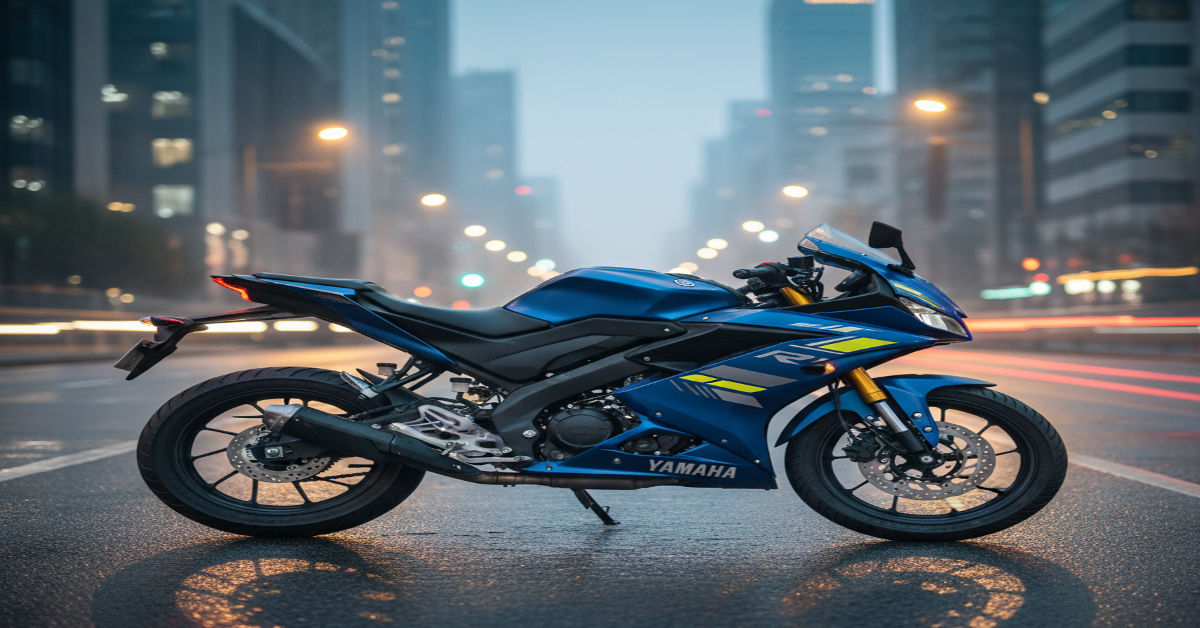In a motorcycle market driven by emotion as much as engineering, Yamaha’s R15 series has become more than just a machine—it’s a rite of passage. Since its debut in 2008, the R15 has defined what an entry-level sport bike could be: affordable, stylish, and relentlessly reliable. Now, in 2025, Yamaha prepares to extend that legacy with the long-anticipated R15 V5, a model positioned not as a revolution but as a meticulous refinement of everything that came before.
The R15 V5 promises updates where they matter most—real-world performance, fuel compatibility, digital connectivity and design sophistication. While Yamaha has not officially confirmed full specifications at the time of writing, insiders and industry analysts describe the V5 as a step forward for India’s most beloved 155 cc sport bike. It represents a strategic balance: advanced technology that remains accessible to riders who use their bikes both for commuting and spirited weekend rides.
The model’s evolution also carries wider implications—how manufacturers in emerging markets are navigating tightening emissions norms, shifting consumer expectations, and the growing fusion of technology and mobility. In short, the R15 V5 isn’t just another sport bike; it’s a barometer for where two-wheeler engineering and lifestyle are heading.
Engineering: The Familiar 155 cc Heart, Refined
At its core, the R15 V5 continues Yamaha’s proven 155 cc liquid-cooled, single-cylinder engine with Variable Valve Actuation (VVA)—a system that automatically switches cam profiles for optimal performance across the rev range. Rather than chasing headline horsepower, Yamaha’s engineers focused on rideability, reducing vibration and optimizing combustion for E20 fuel compatibility—an increasingly important factor as India transitions to ethanol-blended petrol.
The expected output remains around 18–19 PS, but mid-range response and throttle smoothness are improved through ECU recalibration and refined air–fuel mapping. Suspension duties are likely handled by KYB inverted front forks and a linked monoshock, both tuned for urban agility and weekend cornering.
In the words of veteran test rider Rakesh Iyer, who has been part of Yamaha’s evaluation program, “The V5 feels more forgiving. It doesn’t lose its racing DNA, but it’s easier to live with in traffic.”
This evolution, rather than revolution, underscores Yamaha’s philosophy: marginal gains through precision engineering rather than drastic overhauls.
Market Dynamics and Competitive Landscape
The R15 V5 lands in a crowded, highly sensitive price segment where margins are thin and expectations high. Yamaha’s main competitors—KTM RC 125, Suzuki Gixxer SF, and Honda CBR150R—have each staked claims to different parts of the 150 cc sport spectrum. Yet Yamaha retains the strongest emotional pull, particularly among younger urban riders.
| Model | Engine | Power (approx.) | Special Features | Price Range (₹) |
| Yamaha R15 V5 | 155 cc VVA | 18–19 PS | Y-Connect, Quick Shifter | 1.7–1.8 lakh |
| KTM RC 125 | 124.7 cc | 14.5 PS | TFT Display, WP Suspension | 1.9 lakh |
| Suzuki Gixxer SF 155 | 155 cc | 13.4 PS | Fuel Injection, Dual ABS | 1.6 lakh |
| Honda CBR150R | 149 cc | 17 PS | Slipper Clutch, ABS | 1.8 lakh |
Financially, Yamaha’s strategy is calculated: retain the R15’s aspirational status while keeping ownership affordable. The R15’s platform-sharing with models like the MT-15 and XSR155 allows economies of scale in manufacturing, keeping prices stable despite inflation and material costs.
Industry analyst Raghav Singh from Frost & Sullivan summarizes it succinctly:
“The R15 isn’t just a motorcycle; it’s Yamaha’s halo product in India. Its updates ripple through the company’s entire small-displacement lineup.”
Ownership and Practical Reality
For owners in India, Bangladesh, and Pakistan, practicality often defines long-term satisfaction. Beyond the spec sheet, factors such as fuel quality, road conditions, service network reach, and spare-part availability determine a bike’s real-world success.
The R15 line’s reliability and wide service footprint have made it one of the most resale-friendly motorcycles in its class. The V5’s E20-ready engine ensures future fuel compatibility, a reassurance for buyers concerned about government fuel policies. The inclusion of advanced features—like quick-shifters and dual-channel ABS—at accessible price points continues to strengthen Yamaha’s reputation for delivering premium value without premium headaches.
As Arun Mohan a Chennai-based parts distributor puts it:
“The R15 family is an easy recommendation. Every local mechanic knows it, parts are everywhere, and resale is solid. The V5 won’t change that—it’ll reinforce it.”
For young professionals using the bike as both weekday commuter and weekend escape tool, Yamaha’s subtle refinements add up to a more versatile experience without straying from the sport-bike identity.
Design, Style and Emotional Pull
Yamaha’s designers understand that motorcycles are as much about aesthetic identity as engineering. The R15’s “baby superbike” silhouette—derived from the legendary YZF-R1—has always been its most potent marketing weapon. Early glimpses of the V5 suggest sharper bodywork, new LED matrix lighting, and updated graphics designed to echo Yamaha’s larger superbikes.
According to Rahil Singh, a Delhi-based automotive marketing strategist,
“For Gen Z buyers, the R15 isn’t transportation—it’s self-expression. Yamaha’s job is to keep the bike aspirational while staying within reach.”
A subtle redesign keeps the R15 fresh in a segment where style cycles are short and attention spans shorter. By enhancing aerodynamics and visual aggression, Yamaha continues to make the R15 look—and feel—like a scaled-down superbike, preserving its allure for new riders.
Technology and the Future of Small Sport Bikes
The R15 V5 signals a broader shift in two-wheeler engineering. Entry-level sport bikes are no longer judged solely by horsepower—they’re ecosystems of data, safety and sustainability.
- Digital Integration: Systems like Y-Connect turn the motorcycle into a semi-connected device, bridging the gap between analog riding and digital lifestyle.
- Sustainability: Compliance with E20 fuels and BS-VI norms shows how small-engine development can coexist with environmental responsibility.
- Safety: Dual-channel ABS and traction control—once limited to bigger bikes—are becoming standard.
- Manufacturing Efficiency: Global platforms allow cost-sharing while maintaining distinct identities for regional models.
As consultant Silvia Rossi notes,
“The 150 cc sport segment is where innovation meets accessibility. It’s a proving ground for the technologies that will define future mobility.”
For Yamaha, the V5 is more than a model refresh—it’s a reaffirmation of relevance in an era where electric and hybrid mobility looms large.
Key Takeaways
- The Yamaha R15 V5 continues with the proven 155 cc VVA engine, now optimized for E20 fuel and smoother torque delivery.
- It focuses on refinement, not reinvention—better mid-range power, improved electronics, and sharper styling.
- Y-Connect integration enhances digital convenience for connected riders.
- Strong after-sales support and wide availability of spares make it a practical long-term choice.
- Design remains a major selling point—the R15 still looks and feels like a mini-superbike.
- Pricing stability ensures the V5 remains accessible to young professionals and enthusiasts.
- The R15 V5 embodies the next phase of intelligent performance, blending passion with practicality.
Conclusion
If the R15 V4 made Yamaha’s small-displacement sport bike nearly perfect, the V5 seems poised to make it smarter, smoother and more future-proof. It doesn’t chase radical change instead, it elevates the daily riding experience through refinement and integration.
In an age where two-wheelers are pulled between nostalgia and technology, the R15 V5 stands as a balanced bridge. It’s a reminder that evolution, not revolution, often leads to longevity. For Yamaha, this model is both a nod to loyal fans and a signal to the future—a future where motorcycles are not just machines but companions in a connected, sustainable world.
Whether you’re waiting for the V5 or riding the V4 today, the story remains the same: the R15 is more than a motorcycle—it’s a movement on two wheels.
FAQs
1. What’s new in the Yamaha R15 V5?
It builds on the V4 platform with refined torque delivery, updated Y-Connect integration, improved suspension tuning, and new aerodynamic styling.
2. Will the R15 V5 have more power than the V4?
Not significantly. The focus is on improved mid-range performance and fuel compatibility rather than a higher peak horsepower figure.
3. Is the R15 V5 suitable for daily commuting?
Yes. The updated ergonomics, smoother clutch action, and better heat management make it more comfortable in city traffic.
4. How does the R15 V5 compare in value?
It remains competitively priced within the ₹1.7–1.8 lakh range, offering advanced features that maintain its premium value.
5. Should I wait for the R15 V5 or buy the R15 V4?
If you need a bike immediately, the V4 is still excellent. If you prefer the latest tech and can wait, the V5’s refinements may be worth it.







